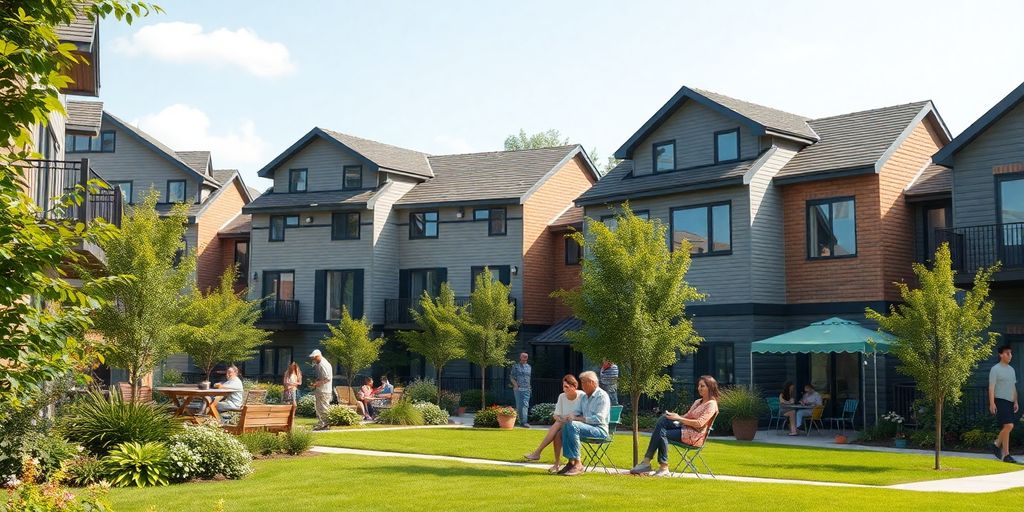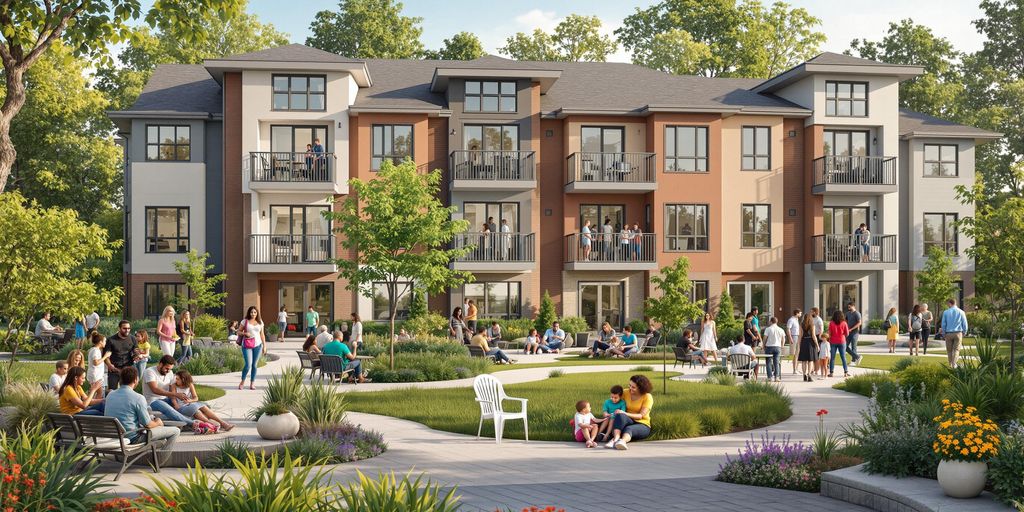Housing finance is on the brink of significant change as we approach 2025. With evolving work habits, economic shifts, and a growing emphasis on sustainability, the way we think about housing is rapidly transforming. The demand for affordable living solutions is at an all-time high, and the industry must adapt to meet these needs. From remote work influencing housing choices to technological advancements reshaping mortgage processes, the landscape is complex but filled with opportunities.
Key Takeaways
- Remote work is reshaping housing demand, favoring suburban and rural areas.
- Interest rates and income inequality continue to affect housing affordability.
- Build-to-rent communities and institutional investors are changing the rental market.
- Technological innovations like AI and VR are transforming real estate processes.
- Sustainable housing solutions are becoming more important due to climate change.
Evolving Work Patterns and Their Impact on Housing Finance

Remote Work and Housing Demand
The pandemic really shook things up, pushing remote work into the spotlight. Now, a lot of folks are rethinking where they want to live. Remote work has untethered employees from the traditional office, sparking a shift in housing preferences. People are looking for homes with office spaces, and they’re not as tied to city centers anymore. It’s like, why pay sky-high rents when you can get more bang for your buck in the suburbs or even rural areas? This shift is changing how housing finance works, as lenders and developers adapt to these new demands.
Suburban Revival and Housing Finance
Suburbs are making a comeback. With remote work, people are flocking to the ‘burbs in search of bigger homes and yards. This revival means housing finance is also shifting gears. Lenders are now focusing more on suburban development projects, offering competitive rates and terms to attract buyers. The finance market is seeing a rise in suburban home loans, and it’s reshaping the landscape as more families settle away from the hustle and bustle of city life.
Office Spaces in Residential Areas
As remote work becomes the norm, the line between home and office blurs. Some neighborhoods are seeing a rise in mixed-use developments, where residential areas include office spaces. This trend is transforming how housing finance is structured. Developers are creating spaces that cater to this hybrid lifestyle, and lenders are offering new types of loans to support these unique properties. It’s a new world where living and working are more intertwined than ever before.
As we adapt to these evolving work patterns, the housing market is undergoing a significant transformation. The future of housing finance is being rewritten, driven by the needs of a workforce that values flexibility and space over proximity to urban centers.
Economic Factors Influencing Housing Finance
Interest Rates and Housing Affordability
Interest rates have always played a big role in the housing market. When rates are low, borrowing is cheaper, making homeownership more accessible. But when they rise, like we’ve seen recently, affordability takes a hit. Higher interest rates mean bigger monthly payments, which can discourage potential buyers. This change not only affects buyers but also impacts the housing market’s overall health. As rates climb, developers might hesitate to start new projects, fearing a lack of buyers.
Income Inequality and Housing Finance
Income inequality is another piece of the housing puzzle. While some people have seen their wages grow, many others haven’t. This gap means that a chunk of the population struggles to afford decent housing. Affordable housing is becoming harder to find, especially in urban areas where prices are skyrocketing. This inequality not only limits where people can live but also affects their quality of life. Addressing this issue is crucial for creating a balanced housing market.
Also Read: The Future of Finance Tech: Innovations Shaping The Financial Landscape in 2025
Government Policies and Housing Solutions
Government policies can either help or hinder the housing market. On one hand, policies that support affordable housing can make a real difference. On the other, some regulations might unintentionally make things worse. For instance, rent control might keep prices down for some, but it could also discourage landlords from maintaining properties or investing in new ones. It’s a delicate balance. Policymakers need to carefully consider the long-term effects of their decisions to ensure they truly benefit the housing market.
The Rise of Build-to-Rent and Institutional Investors

Build-to-Rent Communities
Build-to-rent (BTR) communities are becoming a significant part of the housing market. These are residential developments designed specifically for renting, not selling. This model offers flexibility and convenience, appealing to those who might not be ready to buy a home. In 2025, key factors influencing the Build-to-Rent market include lower capital costs, increased construction starts, and technological advancements.
- Advantages of BTR Communities:
- Predictable rental income for investors
- High-quality amenities for tenants
- Lower maintenance costs due to new construction
Institutional Investors in Housing
Institutional investors, like pension funds and insurance companies, are increasingly drawn to the stable returns provided by rental properties. These investors see BTR as a way to diversify their portfolios and hedge against market volatility. With the growing demand for rental housing, their involvement is likely to rise.
Institutional investors are not just chasing profits; they’re aligning with social goals by investing in sustainable and affordable housing, which helps address pressing societal needs.
Regulation of Rental Platforms
As rental platforms like Airbnb gain popularity, there’s a push for more regulation. This is to ensure fair pricing and protect tenants’ rights. Regulation can help balance the interests of landlords, tenants, and the community, ensuring that rental platforms contribute positively to the housing landscape.
In summary, the rise of build-to-rent communities and institutional investors is reshaping the housing market. As these trends continue, they promise to offer more options for renters and create new opportunities for investors.
Urban Development and Regional Shifts in Housing Finance
Densification and Housing Finance
Urban areas are going through a significant transformation, with densification becoming a key focus. As cities grow, the need to accommodate more people in limited spaces has led to innovative housing solutions. Densification is not just about building more homes; it’s about creating sustainable and livable urban environments. This shift has a direct impact on housing finance, as developers and financiers must adapt to new building codes and regulations that support higher density living.
Adaptive Reuse of Commercial Spaces
The concept of adaptive reuse is gaining traction, especially as many commercial spaces remain vacant post-pandemic. Transforming these spaces into residential units is not only a smart use of resources but also a financial opportunity. It requires a different approach to financing, often involving public-private partnerships to make these projects viable. The challenge lies in balancing the costs of renovation with the potential returns from rent or sale of these newly converted spaces.
15-Minute Cities and Housing Access
The idea of 15-minute cities is reshaping urban planning. The goal is to ensure that all essential services are within a 15-minute walk or bike ride from home. This urban design philosophy promotes sustainability and improves quality of life. For housing finance, this means investing in infrastructure that supports this model, such as public transport and local amenities. It’s a shift that requires collaboration between urban planners, developers, and financial institutions to create communities that are both accessible and affordable.
As we move towards a future where lower mortgage rates and job growth influence housing markets, the integration of these urban development strategies will play a crucial role. Embracing these changes is essential for creating resilient and inclusive communities.
Technological Advancements in Housing Finance
Virtual Reality in Real Estate
Virtual reality (VR) is changing how we buy homes. Imagine touring a house without leaving your couch. That’s the kind of convenience VR offers. It’s not just a gimmick; it makes the buying process smoother and helps buyers make decisions faster. VR can show potential issues in a home that aren’t visible in photos, giving a more complete picture. As VR technology gets better, it will likely become a must-have tool in real estate.
AI and Mortgage Approvals
Artificial intelligence (AI) is stepping into the mortgage world, and it’s making things easier for everyone. By analyzing tons of data quickly, AI can assess risk and approve loans faster than humans. This could mean quicker approvals and fewer headaches for homebuyers. Plus, AI can spot trends and predict future risks, helping lenders make smarter decisions. But there’s a flip side: privacy concerns. As AI digs into personal data, keeping that information safe becomes a big deal.
Smart Home Technology and Housing
Smart home tech isn’t just about cool gadgets; it’s about making life easier and homes more efficient. From smart thermostats to security systems, these devices can save money and energy. For homeowners, this tech can mean lower utility bills and increased property value. Integration is key here—getting all devices to work together seamlessly is where the magic happens. As more people adopt smart home tech, it might even influence home prices and buyer preferences.
As we look at the housing market, technology isn’t just an add-on—it’s becoming a core part of the home buying and owning experience. With tools like VR and AI, the future of housing finance is not just about numbers but also about creating a more connected and efficient living space.
Structured innovation in housing finance is crucial for adapting to these technological shifts. For insights, check out the 2025 Scorecard for Fannie Mae, Freddie Mac, and CSS to understand how these changes are shaping the future.
Climate Change and Sustainable Housing Finance
Energy Efficiency in Housing
As climate change becomes a bigger concern, energy-efficient homes are gaining popularity. These homes not only help reduce utility bills but also cut down on carbon emissions. Energy-efficient housing is becoming a must-have in areas prone to natural disasters. Builders are now focusing on materials and designs that minimize energy use, like better insulation and solar panels. Homeowners can also benefit from tax incentives and rebates, making it more affordable to go green.
Resilient Construction and Housing Finance
Building homes that can withstand extreme weather is another key focus. Resilient construction means using materials and techniques that keep homes safe during hurricanes, floods, or wildfires. This shift is not just about safety; it also affects housing finance. Lenders and insurers are starting to consider climate risks in their assessments. This means that homes built with resilience in mind might get better financing terms or insurance rates. The Climate Risk Committee is working to enhance understanding of these impacts on housing markets.
Mixed-Use Developments and Sustainability
Mixed-use developments are popping up everywhere, combining residential, commercial, and recreational spaces in one area. This approach supports sustainability by reducing the need for long commutes, which cuts down on emissions. These developments often include green spaces and promote walking or cycling, contributing to a healthier lifestyle. For cities, this means a chance to rethink urban planning, making neighborhoods more livable and reducing the environmental footprint.
The future of housing finance is not just about affordability; it’s about creating homes that can withstand the challenges of climate change while promoting a sustainable lifestyle.
Demographic Shifts and Housing Finance Demand
Aging Population and Housing Needs
As we inch closer to 2030, the reality is that all baby boomers will be over 65. This isn’t just a statistic; it’s a monumental shift in housing needs. Older adults are driving the demand for age-friendly housing. Think single-story homes, wider doorways, and easy-to-navigate spaces. It’s not just about downsizing; it’s about finding a place that fits their lifestyle. And let’s not forget, they’re still a significant chunk of the market.
Millennials and Gen Z Housing Preferences
Millennials and Gen Z, on the other hand, are shaking things up. They’re all about urban living, sustainability, and tech-savvy homes. These generations want to be where the action is, in cities with vibrant communities and access to everything they need within a short walk or bike ride. Sustainability is a big deal for them, too, so energy-efficient homes and eco-friendly materials are high on their wish lists.
Urban Living and Housing Finance
Urban areas are buzzing with life, and that’s where a lot of the demand is shifting. Young adults are flocking to cities for the lifestyle and job opportunities. But here’s the kicker: urban housing often comes with a hefty price tag. Financing these homes can be tricky, with high costs and competitive markets. It’s a balancing act between finding the right location and securing the funds to make it happen.
As the population dynamics shift, the housing market must adapt to meet the diverse needs of its inhabitants. Whether it’s accommodating the aging population or catering to the eco-conscious younger generations, the future of housing finance will hinge on understanding these evolving demands.
Innovative Financing Strategies for Affordable Housing
Public-Private Partnerships in Housing
Public-private partnerships (PPPs) are becoming a cornerstone for financing affordable housing projects. By combining resources and expertise from both sectors, PPPs can address the shortage of affordable homes more effectively. These collaborations often involve local governments working closely with private developers and investors to create sustainable housing solutions. One key benefit of PPPs is their ability to leverage private capital for public good, reducing the financial burden on government budgets.
- Local governments can offer incentives such as tax breaks or land grants to encourage private investment.
- Private developers bring in innovative construction techniques and efficient project management.
- Community engagement ensures that the projects meet the needs of local residents.
Creative Financing Solutions
When it comes to affordable housing, traditional financing methods often fall short. Creative financing solutions are essential to bridge the gap. These can include a mix of funding sources, such as social impact bonds, housing trust funds, and tax-exempt bonds. Each of these plays a unique role in supporting housing projects:
- Social impact bonds: These are performance-based investments where returns are contingent on achieving specific social goals.
- Housing trust funds: Established by local or state governments, these funds are dedicated to preserving and producing affordable housing.
- Tax-exempt bonds: Allow private investors to fund public projects with reduced tax liability, shifting some risk away from the public sector.
Policy Shifts and Housing Finance
Policy changes are crucial in shaping the landscape of affordable housing finance. Government policies can either facilitate or hinder the development of affordable housing. Recent shifts have focused on easing regulations and providing more supportive frameworks for developers and investors.
The balance-sheet strength of not-for-profit housing entities is expected to remain stable in 2025, supported by strong management practices. The Federal Reserve’s monetary easing in 2024 is projected to contribute positively to this outlook.
- Zoning reforms can make it easier to build multi-family units in urban areas.
- Incentives for green building practices can encourage sustainable development.
- Streamlined approval processes can reduce the time and cost involved in starting new projects.
These innovative strategies are essential for addressing the ongoing affordable housing crisis, ensuring that everyone has access to safe and affordable homes.
Conclusion
As we look toward 2025, the landscape of housing finance is set to undergo significant changes. The shift to remote work, economic factors, and the rise of new housing models are reshaping how we think about affordable living. While challenges like rising costs and income inequality persist, there are also opportunities for innovation in financing and policy. The future of housing finance will require adaptability and creativity from all stakeholders, including homeowners, investors, and policymakers. By embracing new strategies and technologies, we can work towards a more affordable and sustainable housing market for everyone.
Frequently Asked Questions
How does remote work affect housing demand?
Remote work means more people can live further from big cities. This might make suburban and rural homes more popular.
Why are interest rates important for buying a home?
Interest rates decide how much extra money you pay when you borrow to buy a house. Lower rates make homes cheaper to buy.
What is build-to-rent?
Build-to-rent means homes are built just for renting, not selling. This can give more people a place to live without buying.
How does technology help in buying a house?
Technology like virtual reality lets you tour homes online. AI can help banks decide who gets a loan quickly.
Why is energy efficiency important in homes?
Energy-efficient homes use less power, saving money and helping the planet by reducing pollution.
What are public-private partnerships in housing?
These are deals where the government and private companies work together to make housing more affordable.










1 comment